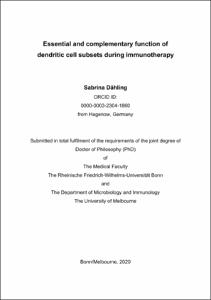Dähling, Sabrina: Essential and complementary function of dendritic cell subsets during immunotherapy. - Bonn, 2020. - Dissertation, Rheinische Friedrich-Wilhelms-Universität Bonn, University of Melbourne.
Online-Ausgabe in bonndoc: https://nbn-resolving.org/urn:nbn:de:hbz:5n-57986
Online-Ausgabe in bonndoc: https://nbn-resolving.org/urn:nbn:de:hbz:5n-57986
@phdthesis{handle:20.500.11811/8336,
urn: https://nbn-resolving.org/urn:nbn:de:hbz:5n-57986,
author = {{Sabrina Dähling}},
title = {Essential and complementary function of dendritic cell subsets during immunotherapy},
school = {{Rheinische Friedrich-Wilhelms-Universität Bonn} and {University of Melbourne}},
year = 2020,
month = mar,
note = {T lymphocytes are critical components of the adaptive immune system that protects us against a variety of infections. However, during chronic infections such as with HIV, HCV and HBV as well as cancers, T cells become functionally impaired in order to limit immunopathology. This in turn allows these infections to persist or tumours to grow and spread. Scientific research over the last decades lead to the development of checkpoint inhibitors which can reinvigorate exhausted CD8+ T cells. This enables them to fight persisting infections and to eliminate even advanced tumours. Based on this success, checkpoint immunotherapy has revolutionized cancer treatment. With the identification of the memory-like TCF-1+ subset of exhausted CD8+ T cells that responds to checkpoint immunotherapy, predictions for clinical responses can be further improved. Yet, despite the enormous success and routine application, a deeper mechanistic understanding of checkpoint immunotherapy is required in order to help patients in whom this therapy failed.
In this study, we elucidate critical cellular interaction partners of exhausted CD8+ T cells during anti-PD-L1 treatment. Using the murine chronic LCMV model, we found that DC with their key function in T cell activation are pivotal for a successful therapy demonstrated by the expansion of virus-specific CD8+ T cells and control of viral load. Notably, different DC subsets represent complementary roles in this context. The cross-presenting subset of XCR1+ DC are critical to maintain the population of memory-like TCF-1+ exhausted CD8+ T cells while the remaining DC promote proliferation of such. Data presented in this study indicate that a complex network of signalling molecules delivered by DC subsets is involved in this process. Performing detailed transcriptional analysis of memory-like TCF-1+ cells, we deciphered that this cell pool represents a heterogenous population and our results imply that the different subsets reside in different areas of secondary lymphoid organs. Investigation of the microanatomy of the CD8+ T cell – DC interaction revealed three distinct areas of the spleen where communication of the cellular subsets occurs.
Taken together, we elucidated a complex interplay between exhausted CD8+ T cells and DC during chronic viral infection and anti-PD-L1 treatment. This communication impacts on the transcriptional and functional level of exhausted CD8+ T cells as well as on their localization in secondary lymphoid organs. Overall, our data identified critical cellular interaction partners and their specific anatomical localization that is essential for the successful reinvigoration of exhausted CD8+ T cells during checkpoint immunotherapy.},
url = {https://hdl.handle.net/20.500.11811/8336}
}
urn: https://nbn-resolving.org/urn:nbn:de:hbz:5n-57986,
author = {{Sabrina Dähling}},
title = {Essential and complementary function of dendritic cell subsets during immunotherapy},
school = {{Rheinische Friedrich-Wilhelms-Universität Bonn} and {University of Melbourne}},
year = 2020,
month = mar,
note = {T lymphocytes are critical components of the adaptive immune system that protects us against a variety of infections. However, during chronic infections such as with HIV, HCV and HBV as well as cancers, T cells become functionally impaired in order to limit immunopathology. This in turn allows these infections to persist or tumours to grow and spread. Scientific research over the last decades lead to the development of checkpoint inhibitors which can reinvigorate exhausted CD8+ T cells. This enables them to fight persisting infections and to eliminate even advanced tumours. Based on this success, checkpoint immunotherapy has revolutionized cancer treatment. With the identification of the memory-like TCF-1+ subset of exhausted CD8+ T cells that responds to checkpoint immunotherapy, predictions for clinical responses can be further improved. Yet, despite the enormous success and routine application, a deeper mechanistic understanding of checkpoint immunotherapy is required in order to help patients in whom this therapy failed.
In this study, we elucidate critical cellular interaction partners of exhausted CD8+ T cells during anti-PD-L1 treatment. Using the murine chronic LCMV model, we found that DC with their key function in T cell activation are pivotal for a successful therapy demonstrated by the expansion of virus-specific CD8+ T cells and control of viral load. Notably, different DC subsets represent complementary roles in this context. The cross-presenting subset of XCR1+ DC are critical to maintain the population of memory-like TCF-1+ exhausted CD8+ T cells while the remaining DC promote proliferation of such. Data presented in this study indicate that a complex network of signalling molecules delivered by DC subsets is involved in this process. Performing detailed transcriptional analysis of memory-like TCF-1+ cells, we deciphered that this cell pool represents a heterogenous population and our results imply that the different subsets reside in different areas of secondary lymphoid organs. Investigation of the microanatomy of the CD8+ T cell – DC interaction revealed three distinct areas of the spleen where communication of the cellular subsets occurs.
Taken together, we elucidated a complex interplay between exhausted CD8+ T cells and DC during chronic viral infection and anti-PD-L1 treatment. This communication impacts on the transcriptional and functional level of exhausted CD8+ T cells as well as on their localization in secondary lymphoid organs. Overall, our data identified critical cellular interaction partners and their specific anatomical localization that is essential for the successful reinvigoration of exhausted CD8+ T cells during checkpoint immunotherapy.},
url = {https://hdl.handle.net/20.500.11811/8336}
}






